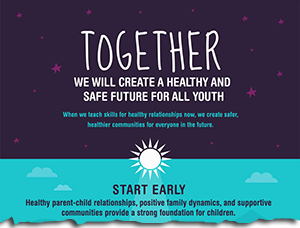Unhealthy relationships can start early and last a lifetime. Teens often think some behaviors, like teasing and name-calling, are a “normal” part of a relationship. However, these behaviors can become abusive and develop into more serious forms of violence.
What is dating violence?
Teen dating violence[PDF 187KB] is defined as the physical, sexual, psychological, or emotional violence within a dating relationship, including stalking. It can occur in person or electronically and might occur between a current or former dating partner. Several different words are used to describe teen dating violence.  Below are just a few.
Below are just a few.
- Relationship abuse
- Intimate partner violence
- Relationship violence
- Dating abuse
- Domestic abuse
- Domestic violence
Dating violence is widespread with serious long-term and short-term effects. Many teens do not report it because they are afraid to tell friends and family. A 2017 CDC Report[PDF 4.32MB] found that approximately 7% of women and 4% of men who ever experienced rape, physical violence, or stalking by an intimate partner first experienced some form of partner violence by that partner before 18 years of age. The 2013 national Youth Risk Behavior Surveyfound approximately 10% of high school students reported physical victimization and 10% reported sexual victimization from a dating partner in the 12 months* before they were surveyed.
*Vagi, K. J., Olsen, E. O., Basile, K. C., & Vivolo-Kantor, A. M. (2015). Teen dating violence (physical and sexual) among US high school students: Findings from the 2013 National Youth Risk Behavior Survey. JAMA Pediatrics, 169, 474-482.
What are the consequences of dating violence?
Teen Dating Violence Prevention Infographic
The infographic highlights the importance of healthy relationships throughout life. Find various ways to share the infographic with partners.
As teens develop emotionally, they are heavily influenced by experiences in their relationships. Healthy relationship behaviors can have a positive effect on a teen’s emotional development. Unhealthy, abusive, or violent relationships can have severe consequences and short- and long-term negative effects on a developing teen. Youth who experience dating violence are more likely to experience the following:
- Symptoms of depression and anxiety
- Engagement in unhealthy behaviors, such as tobacco and drug use, and alcohol
- Involvement in antisocial behaviors
- Thoughts about suicide
Additionally, youth who are victims of dating violence in high school are at higher risk for victimization during college.
Why does dating violence happen?
Communicating with your partner, managing uncomfortable emotions like anger and jealousy, and treating others with respect are a few ways to keep relationships healthy and nonviolent. Teens receive messages about how to behave in relationships from peers, adults in their lives, and the media. All too often these examples suggest that violence in a relationship is normal, but violence is never acceptable. There are reasons why violence occurs.
Violence is related to certain risk factors. Risks of having unhealthy relationships increase for teens who:
- Believe that dating violence is acceptable
- Are depressed, anxious, or have other symptoms of trauma
- Display aggression towards peers or display other aggressive behaviors
- Use drugs or illegal substances
- Engage in early sexual activity and have multiple sexual partners
- Have a friend involved in dating violence
- Have conflicts with a partner
- Witness or experience violence in the home
Dating violence can be prevented when teens, families, organizations, and communities work together to implement effective prevention strategies.
The following resources provide more information on teen dating violence and its prevention:
Publications
- Understanding Teen Dating Violence Fact Sheet[PDF 187KB]
- Physical Dating Violence Among High School Students—United States, 2003
Additional CDC Resources
- Dating Matters: Understanding Teen Dating Violence Prevention
Dating Matters® is a comprehensive teen dating violence prevention model developed and tested by CDC to reduce dating violence and increase healthy relationships through multilevel, multisector prevention efforts– in schools, families, neighborhoods, and communities– led by local health departments. Follow this link for more information on the Dating Matters model, current research evidence, and access to the Dating Matters youth and parent programs, educator trainings, implementation guidance, and other resources. - CDC TV’s Break the Silence: Stop the Violence
In this video, parents talk with teens about developing healthy, respectful relationships before they start dating. - Division of Adolescent and School Health
This CDC Division promotes the health and well-being of children and adolescents to enable them to become healthy and productive adults. - Preventing Intimate Partner and Sexual Violence: Program Activities Guide[PDF 8.37MB]
This guide describes CDC’s public health activities and research related to intimate partner and sexual violence.
Additional Federal Resources
- Department of Justice’s Violence Against Women Office
- Youth.gov
- Office on Women’s Health: Violence Against Women topics and resources
- Office for Victims of Crime
Hotlines
- National Domestic Violence Hotline
- Love is Respect
- National Sexual Assault Hotline
- National Sexual Assault Online Hotline
Resource Centers
- National Online Resource Center on Violence Against Women
- The National Sexual Violence Resource Center
- PreventConnect
- National Resource Center on Domestic Violence


